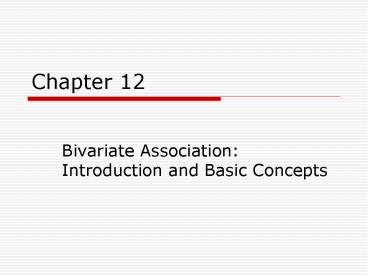Bivariate Association: Introduction and Basic Concepts - PowerPoint PPT Presentation
Title:
Bivariate Association: Introduction and Basic Concepts
Description:
Title: Chapter 12 -14 Bivariate Association with Bivariate Tables and Associated Statistics Author: Joe Healey Last modified by: Stacy SCHOOLFIELD – PowerPoint PPT presentation
Number of Views:218
Avg rating:3.0/5.0
Title: Bivariate Association: Introduction and Basic Concepts
1
Chapter 12
- Bivariate Association Introduction and Basic
Concepts
2
Chapter Outline
- Statistical Significance and Theoretical
Importance - Association Between Variables and the Bivariate
Table - Three Characteristics of Bivariate Associations
3
Introduction
- Two variables are said to be associated when they
vary together, when one changes as the other
changes. - Association can be important evidence for causal
relationships, particularly if the association is
strong.
4
Introduction
- If variables are associated, score on one
variable can be predicted from the score of the
other variable. - The stronger the association, the more accurate
the predictions.
5
Association and Bivariate Tables
- Bivariate association can be investigated by
finding answers to three questions - Does an association exist?
- How strong is the association?
- What is the pattern or direction of the
association?
6
Association and Bivariate Tables Problem 12.1
- The table shows the relationship between
authoritarianism of bosses (X) and the efficiency
of workers (Y) for 44 workplaces.
Low High
Low 10 12 22
High 17 5 22
27 17 44
7
Is There an Association?
- An association exists if the conditional
distributions of one variable change across the
values of the other variable. - With bivariate tables, column percentages are the
conditional distributions of Y for each value of
X. - If the column change, the variables are
associated.
8
Association and Bivariate Tables
- The column is (cell frequency / column total)
100. - Problem 12.1
- (10/27)100 37.04
- (12/17) 100 70.59
- (17/27)100 62.96
- (5/17)100 29.41
Low High
Low 10 (37.04) 12 (70.59) 22
High 17 (62.96) 5 (29.41) 22
27 (100.00) 17 (100.00) 44
9
Is There an Association?
- The column s show efficiency of workers (Y) by
authoritarianism of supervisor (X). - The column s change, so these variables are
associated.
Low High
Low 37.04 70.59
High 62.96 29.41
100 100
10
How Strong is the Association?
- The stronger the relationship, the greater the
change in column s (or conditional
distributions). - In weak relationships, there is little or no
change in column s. - In strong relationships, there is marked change
in column s.
11
How Strong is the Association?
Difference Strength
Between 0 and 10 Weak
Between 10 and 30 Moderate
Greater than 30 Strong
- One way to measure strength is to find the
maximum difference, the biggest difference in
column s for any row of the table.
12
How Strong is the Association?
- The Maximum Difference in Problem 12.1 is 70.59
37.04 33.55. - This is a strong relationship.
Low High
Low 37.04 70.59
High 62.96 29.41
100 100
13
What is the Pattern of the Relationship?
- Pattern which scores of the variables go
together? - To detect, find the cell in each column which has
the highest column .
14
What is the Pattern of the Relationship?
- Low on Authoritarianism goes with High on
efficiency. - High on Authoritarianism goes with Low in
efficiency.
Low High
Low 37.04 70.59
High 62.96 29.41
100 100
15
What is the Direction of the Relationship?
- If both variables are ordinal, we can discuss
direction as well as pattern. - In positive relationships, the variables vary in
the same direction. - As one increases, the other increases.
- In negative relationships, the variables vary in
opposite directions. - As one increases, the other decreases.
16
What is the Direction of the Relationship?
- Relationship in Problem 12.1 is negative.
- As authoritarianism increases, efficiency
decreases. - Workplaces high in authoritarianism are low on
efficiency.
Low High
Low 37.04 70.59
High 62.96 29.41
100 100
17
What is the Direction of the Relationship?
- This relationship is positive.
- Low on X is associated with low on Y.
- High on X is associated with high on Y.
- As X increase, Y increases.
Low High
Low 60 30
High 40 70
100 100
18
Summary Problem 12.1
- There is a strong, positive relationship between
authoritarianism and efficiency. - These results would be consistent with the idea
that authoritarian bosses cause inefficient
workers (mean bosses make lazy workers). - But
Low High
Low 37.04 70.59
High 62.96 29.41
100 100
19
Summary Strength and Direction
- These results are also consistent with the idea
that inefficient workers cause authoritarian
bosses (lazy workers make mean bosses).
Low High
Low 37.04 70.59
High 62.96 29.41
100 100
20
Correlation vs. Causation
- Correlation and causation are not the same
things. - Strong associations may be used as evidence of
causal relationships but they do not prove
variables are causally related. - What else would we need to know to be sure there
is a causal relationship between authoritarianism
and efficiency?































